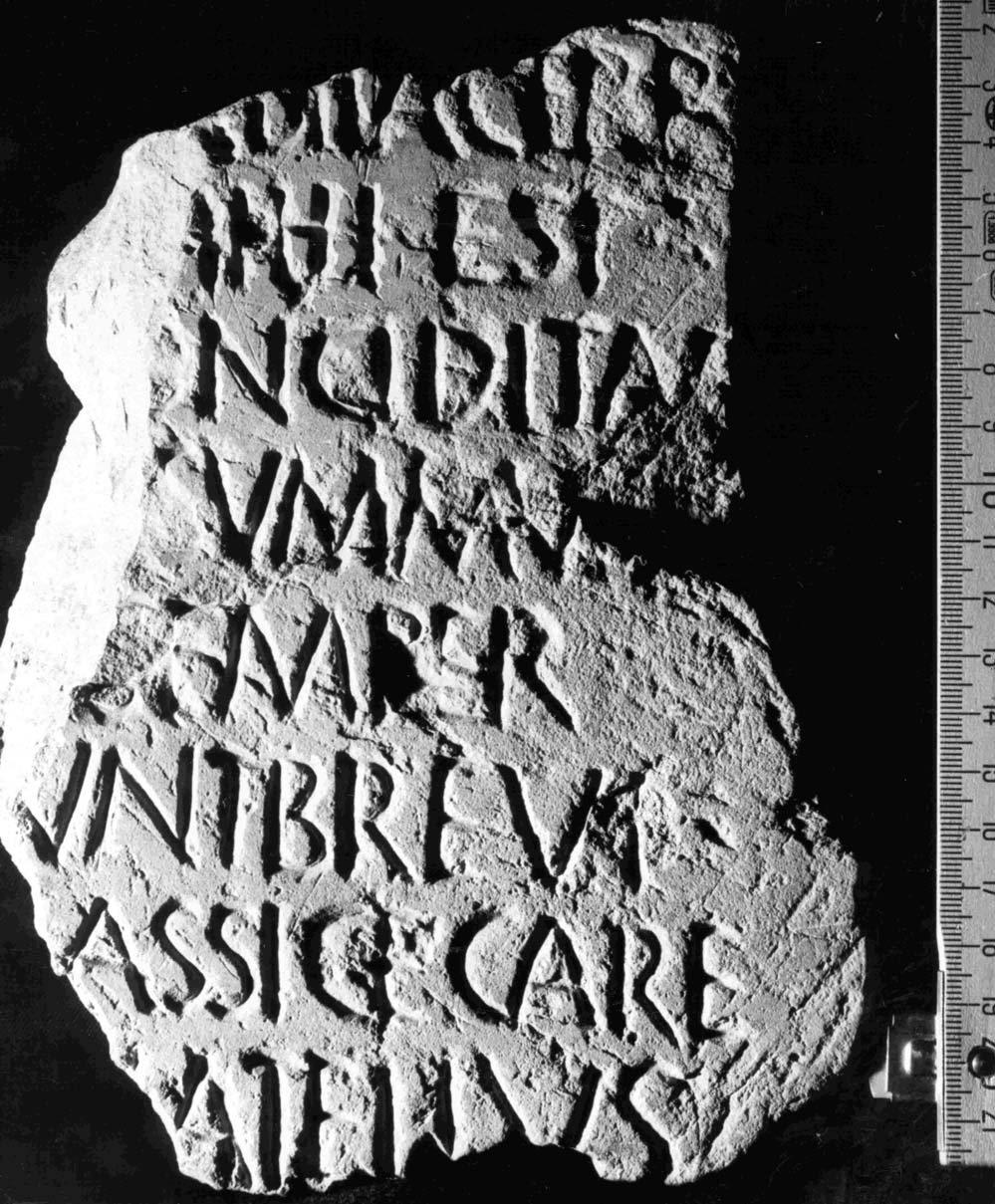Funerary carmen
Reference CIL II2/7, 775 | Description | Lyrics | Location | Chronology | Epigraphic edition | Translation | Apparatus | Comentary | Type of verse | Text divided into verses and metric signs | Images | Bibliography | Link to DB | Author |
Funerary carmen
Description
- Idno filename 22/01/0041
- Type of inscription: Sepulcralis
- Material: Limestone
- Conservation status: Fragment.
- Dimensions height/width/depth (cm): 22/18/12.5
-
Epigraphic field:
- Layout: Good "ordinatio".
- Preserved
Lyrics
- Font:Capital cuadrada
- Letter size:2 cm
- Description of the letters:Letters very deeply cut.
Location
- Place of discovery: Found in Fuencaliente (Ciudad Real), in La Dehesa, where there is now a football pitch.
- Geolocation
- Conservation location: it is preserved in the MAP in Ciudad Real.
- Inventory number: 403/04
- Location with Modern Nomenclature España / Ciudad Real / Fuencaliente
- Location with Old Nomenclature Hispania / Baetica / Cordubensis / Solia
Chronology
- Inscription's dating: Between year 1 and year 99
- Dating explanation: From the 1st c. AD approximately, from the form of the letters.
Type of verse
- Type of verse: Dactílico (hexámetro)
- Verse/line correspondence: No
- Prose/verse distinction: No
Epigraphic edition
‑ ‑ ‑ ‑ ‑ ‑
[‑ ‑ ‑]+ḅit acerb+[‑ ‑ ‑]
[‑ ‑ ‑] mihi est ▴
[‑ ‑ ‑ c]ọncidit a[etas]
5 [‑ ‑ ‑] summus [‑ ‑ ‑]
[‑ ‑ ‑] ṣemper
[‑ ‑ ‑]unt brevi[ter?]
[‑ Cl]assice care
[‑ ‑ ‑]+a tẹḷḷus
10 ‑ ‑ ‑ ‑ ‑ ‑?
Text divided into verses and metric signs
‑ ‑ ‑ ‑ ‑ ‑
[‑ ‑ ‑]bit acerb[‑ ‑ ‑] [ln|ln|ln|ln|l]kk|l[~]
[‑ ‑ ‑] mihi est [ln|ln|l||lkk|l]kk|~
[‑ ‑ ‑ c]oncidit ae[tas] [ln|ln|ln|ln]|lkk|l[~]
5 [‑ ‑ ‑] summus [‑ ‑ ‑] [ln|ln|l||lkk]|lk[k|~] o bien [ln|ln|ln|ln]|lk[k|l~]
[‑ ‑ ‑] semper [ln|ln|ln|ln|lkk]|l~
[‑ ‑ ‑]unt brevia [ln|ln|l||lkk]|lkk|~
[‑ – – Cl]assice care [ln|ln|ln|ln]|lkk|l~
[‑ ‑ ‑]a tellus [ln|ln|ln|ln|lk]x|l~
10 ‑ ‑ ‑ ‑ ‑ ‑?
Bibliography
Alföldy 1987, 229–234 adn. 3 cum im. phot. (AE 1987, 683; HEp 1990, 286); id., II2/7, 775, cum im. phot. in micr.; Fernández Martínez-Carande, CLEB, CR1 cum im. phot.; Abascal – García 2009, 269; Cugusi 2012, 33. – Cf. Hernández Pérez 2001a, 168–169.
Apparatus
1 abit acerbu[—] Alföldy; [casum miser]abit coniecit Cugusi dubitanter. – 3 + agnotum uti litt. E aut F Alföldy. – 7 [—Cl]assice Alföldy. – 8 +ATE++VS Alföldy, qui +++ pro summa trium rectorum ductuum parte accipit.
Comentary
A funerary carmen dedicated to a man (Classico) and composed in dactylic verse; because of the lack of preserved text it is not clear whether it is a succession of hexameters or elegiac distichs. In l. 1, -[a]bit appears to correspond to a future verb ending. In l. 3, the sequence [c]oncidit aetas has numerous epigraphical parallels, cf. CLE 376, 2 and 1966A. In l. 6, the cretic sequence sunt brevi could be avoided by following Alföldy 1987, 230, who took the following sign to be an indication of abbreviation (from breviter) instead of an interpunction. L. 8: it is very frequent to find tellus to refer to the origin of the deceased (1945, 2 Tiburtia tellus; 1312, 1 tellus Maurusia; 474, 3 Italia tellus), especially it the latter has been buried away from his or her homeland, a topos frequently found in association with that of mors immatura, thus in 1026, 1 Itala me rapuit crudeli funere tellus; 963, 11 quem Phrygia edidit tellus. There are no examples to verify that this cognomen was attested in Hispania (this would be the only case) but there are many in Rome (cf. Abascal 1994, p. 330 y Kajanto 1982, p. 319, where 18 examples are registered in CIL VI, 14 masculine et 4 feminine), which seems like one more argument to prove this hypothesis.
Alföldy restored the carmen as follows as a part of a game (in three elegiac distichs and two hexameters), from where AE, HEp:
Me, donec vivam, dolor excruciabit acerbus,
stirps mea quod misero funere rapta mihi est.
Strage repentina puerilis concidit aetas
eripuitque dies lumine summus eam.
5 Tristis et infelix percontor numina semper:
Cur non me, quaeso, diripiunt breviter?
Nunc, cum conditus in tumulo sis, Classice care,
contegat ossa et sit tibi perpetuo pia Tellus.
Author
- Author:R. Carande Herrero, C. Fernández Martínez, J. M. Escolà Tusset, J. Martínez Gázquez
- Last Update2024-02-25 17:42:26
- Autopsy date:2004
You can download this





